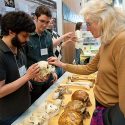David Krakauer nurtures scientific collaboration
David Krakauer, the new director of the Wisconsin Institute for Discovery, discusses his thoughts on “transcience” and scientific collaboration.
Photo: Bryce Richter
Education and research are splintering into new specialties at an unsustainable rate, according to David Krakauer.
Recently installed as the first permanent director of the Wisconsin Institute for Discovery, Krakauer has a different idea of the best way to train future scientists and enable researchers, fostered over the last nine years on the faculty at the private Santa Fe Institute in Santa Fe, N.M.
On the occasion of the first anniversary of the opening of the Wisconsin Institutes for Discovery building on University Avenue, Inside UW caught up with the Hawaii-born, Portugal-and-England-raised, Oxford-educated Krakauer to talk about his expectations for his new appointment.
iUW: Why leave the Santa Fe Institute for the University of Wisconsin–Madison?
Krakauer: I want to explore something new. SFI is an isolated place in the mountains incubating a new brand of scientific thinking — a trans-disciplinary approach — that is ripe for export. It’s a bit like starting a plant in a greenhouse before you move it outdoors. Coming here is an opportunity to extend that idea to a larger community with broader demographics. It’s key that different lines of thinking sort of refresh or alter our approach to research, and this university has incredible scale. Madison has a significant representation, and critical mass in so many areas of scholarship. This is a huge resource we just didn’t have at SFI.
iUW: How does this approach, which you call “transcience,” differ from research and learning as we may understand it at UW–Madison?
Krakauer: Murray Gell-Mann, a faculty member at Santa Fe Institute and Nobel Prize winner, if you ask him what a physicist is, he wouldn’t mention forces, fields or particles or any of that. He’d say, “It’s a style of thinking.” Most science is divided into disciplines defined by spatial organization: looking at molecules is different than looking at cells is different than looking at computer chips, right? This transcience concept, it’s not defined by the object of study, but by analogous structures and dynamics. If we know that a cell responds to information much like a computer network, why not apply the same insights to research on both?
iUW: If the approach to research at WID will be atypical, what does a successful institute look like?
Krakauer: The standard metrics of productivity are papers and publications, grants and teaching. They’re all fairly easily quantified, even if the metrics aren’t perfect. Our metrics at the WID will be harder to quantify. We’ll be looking at density of collaborative networks and diffusion of ideas and techniques. How long does it take for information to spread, and how many people pass it along? The intangibles are important. Do we have people who are dedicating time to areas that aren’t their research focus? Are the people here people who participate and lend their time to community efforts? Are they engaged outside their labs? Can you knock on their door with a question and end up in a good discussion outside of their comfort zone? It’s hard to measure an environment like that, but you know when you’re in one.
iUW: Why foster an environment that may seem out of the norm and difficult to grasp?
Krakauer: Ideas of consequence have often come from people who are outsiders to the field. Consider one the major developments in biology from the last century associated with (James) Watson and (Francis) Crick – this is a partnership between a biologist and a physicist. And consequential ideas tend to emerge in open, supportive environments. There are places and times that make innovative ideas more likely to happen. If you ask someone how that environment came about, they never say, ‘Well, I got all the money I wanted.’ It’s always, ‘I was with the most amazing people.’ You can’t engineer the ultimate collaboration. You can engineer an environment where people feel comfortable collaborating.
iUW: You’ve said WID needs to make visitors say “Wow.” How do you do that?
Krakauer: We have a head start with the building. It’s beautiful, and that’s good. But there’s a vibrancy to a place that makes it exciting, and that’s up to the people who inhabit it. So when I say, “Wow,” that’s people on the ground. That’s a conversation happening that includes some amazing people and this is going to take a while to develop, but Madison has something that many places do not. People here — faculty included — are predisposed to get involved. If you can help provide them some time to allow them to get out from behind their desks and an interesting conversation to join, we can take advantage of that. And then as they say, the sky is the limit.



